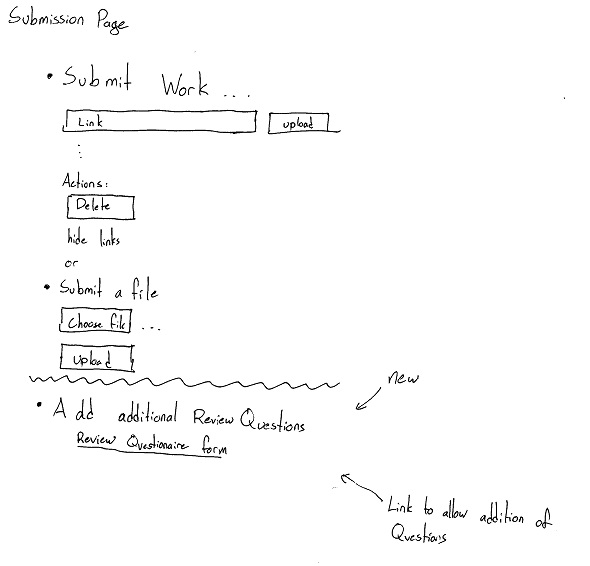E1875 Revision Planning Tool: Difference between revisions
| Line 10: | Line 10: | ||
*** How effectively did feature X address / solve issues a, b and c? | *** How effectively did feature X address / solve issues a, b and c? | ||
*** Did modification of feature Y resolve error d? | *** Did modification of feature Y resolve error d? | ||
* | * The new questionnaire must be linked to the second-round questionnaire. | ||
* | * The new questionnaire must be part of the team's submission records. | ||
<br/> | <br/> | ||
== Problem Statement == | == Problem Statement == | ||
In the 2nd round of reviews, the Author should be able to add a statement to direct towards Author selected improvements from Round 1 to Round 2. | In the 2nd round of reviews, the Author should be able to add a statement to direct towards Author selected improvements from Round 1 to Round 2. | ||
Revision as of 19:55, 24 April 2019
What's it about?
In the first round of Expertiza reviews, we ask reviewers to give authors some guidance on how to improve their work. Then in the second round, reviewers rate how well authors have followed their suggestions. We could carry the interaction one step further if we asked authors to make up a revision plan based on the first-round reviews. That is, authors would say what they were planning to do to improve their work. Then second-round reviewers would assess how well they did it. In essence, this means that authors would be adding criteria to the second-round rubric that applied only to their submission. We are interested in having this implemented and used in a class so that we can study its effect.
What needs to be done?
- Develop UI for authors to create new questions to add to the second round-rubric. This should be a form that includes the following:
- A description of the revision plan. Eg: We will add feature X to address issues a,b and c. We will modify feature Y and expect it to resolve errors d, c and e.
- One or more questions for every proposed improvement. Example:
- How effectively did feature X address / solve issues a, b and c?
- Did modification of feature Y resolve error d?
- The new questionnaire must be linked to the second-round questionnaire.
- The new questionnaire must be part of the team's submission records.
Problem Statement
In the 2nd round of reviews, the Author should be able to add a statement to direct towards Author selected improvements from Round 1 to Round 2.
Motivation
The OSS and Final projects are different for every team. From a reviewers perspective, not all questions make sense for all projects. The motivation behind this project is:
- Questions unique to each project gives the reviewers a perspective on the author’s objectives.
- Allow the Author to get feedback on whether or not they accomplished their self-directed goal.
Criteria for completion
- Direct user to Revision Planning Questionnaire.
- Create a form for the Assignment Team to add Questions to a Questionnaire that are specific to that Submission in the second round of submission.
- Append Revision Planning Questionnaire to 2nd Round Review Questionnaire.
UI mockups
The first image shows a mockup of what the Author will see on the submission page to submit new additional questions for review.

Second is a view of what the reviewer will see. It should blend in with the review questions submitted by the instructor for all similar projects.

Files modified
Controllers
- grades_controller.rb
- questionnaires_controller.rb
- response_controller.rb
- submitted_content_controller.rb
Views
- questionnaires/_questionnaire.html.erb
- submitted_content/edit.html.erb
- submitted_content/edit.html.erb
Models
Database
Specs
- grades_controller_spec.rb
- questionnaires_controller_spec.rb
- factories.rb
- assignment_submission_spec.rb
- answer_spec.rb
- revision_review_questionnaire_spec.rb
config
Test Plan and Demo
Test Plan
- Login as 'super_administrator2' with password 'password'.
- Make an assignment with the name 'Assignment1'.
- Make the following selections:
- Review Strategy: Allow authors to add to rubric.
- Rubric: Rubric varies by round.
- Add participants: Add existing students - student1, student2
- Due Dates: Add deadlines for rounds.
- Add topics to the assignment
- Set 2 rounds of submissions and reviews.
- Impersonate student1.
- Signup for topic and form team.
- Make submissions in round 1 submission.
- Move to round 1 review stage.
- Impersonate student2.
- Make submissions in round 1 and review it.
- Move to round 2 submission stage
- Impersonate student1.
- Submit a revision plan in the 'Your Work' handle.
- Repeat above two steps for student2.
- Move to round 2 review.
- Impersonate student2.
- Verify that revision plan questions are added to the review by student1'team and submit the review.
- impersonate student1.
- Repeat the above two steps for student1.
- Verify that review has been received on the revision plan questions after assignment is finished.